2021 Research Using Robo-Met's Materials Analysis
July 22, 2021
![]() Check out some of this year's new insights uncovered through Robo-Met.3D®'s automated serial sectioning. Contact us to learn more about how you can use Robo-Met to get the material insights you need today.
Check out some of this year's new insights uncovered through Robo-Met.3D®'s automated serial sectioning. Contact us to learn more about how you can use Robo-Met to get the material insights you need today.
Read also: Robo-Met Publications in 2020 | 2019 | 2018 | 2017
Category: Structural Metals
Effect of thermo-mechanical treatment and strontium addition on workability and mechanical properties of AlSiCu casting alloy
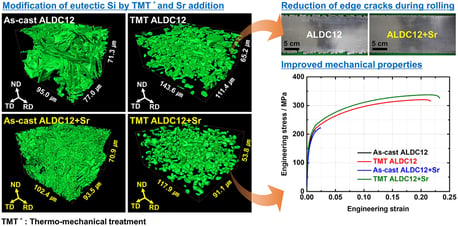 In this study, the potential application of Al-Si-Cu aluminum alloy (ALDC12), which is widely used in the high-pressure die-casting (HPDC) process, for fabricating a wrought product was evaluated. The effects of thermo-mechanical treatment and Sr addition on the microstructure, workability, and mechanical properties of the ALDC12 alloy were investigated in detail. The introduction of thermo-mechanical treatment significantly reduced the interconnectivity of the brittle eutectic Si phase formed during solidification and average grain size. Therefore, the uniformly distributed spherical Si particles and fine grain size considerably improved both the strength and ductility of the ALDC12 alloy. Furthermore, the addition of Sr effectively modified the eutectic Si phase in the casting process, which significantly reduced the occurrence of edge cracks in the subsequent rolling step and further improved the mechanical properties of the final sheets. Consequently, through microstructural control of the ALDC12 aluminum alloy by the thermo-mechanical treatment and Sr addition, it was possible to obtain suitable workability and significantly improved mechanical properties compared with those of cast products.
In this study, the potential application of Al-Si-Cu aluminum alloy (ALDC12), which is widely used in the high-pressure die-casting (HPDC) process, for fabricating a wrought product was evaluated. The effects of thermo-mechanical treatment and Sr addition on the microstructure, workability, and mechanical properties of the ALDC12 alloy were investigated in detail. The introduction of thermo-mechanical treatment significantly reduced the interconnectivity of the brittle eutectic Si phase formed during solidification and average grain size. Therefore, the uniformly distributed spherical Si particles and fine grain size considerably improved both the strength and ductility of the ALDC12 alloy. Furthermore, the addition of Sr effectively modified the eutectic Si phase in the casting process, which significantly reduced the occurrence of edge cracks in the subsequent rolling step and further improved the mechanical properties of the final sheets. Consequently, through microstructural control of the ALDC12 aluminum alloy by the thermo-mechanical treatment and Sr addition, it was possible to obtain suitable workability and significantly improved mechanical properties compared with those of cast products.The contribution of aluminides to strength of Al–Mg2Si–Cu–Ni alloys at room and elevated temperatures.

Effect of Ultrasonic Melt Treatment on Solidification Microstructure of Al–5Ti–1B Alloy Containing Numerous Inoculant Particles
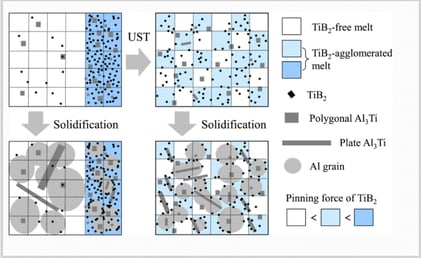
Category: Additive Manufacturing Applications
Flaw Identification in Additively Manufactured Parts Using X-ray Computed Tomography and Destructive Serial Sectioning
In additive manufacturing (AM), internal flaws that form during processing can have a detrimental impact on the resulting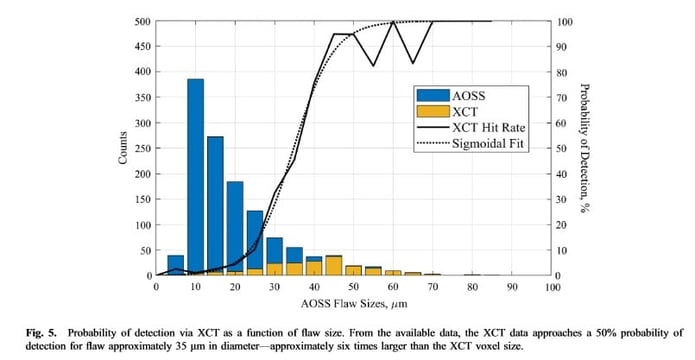 fatigue behavior of the component. Nondestructive x-ray computed tomography (XCT) has been routinely used to inspect AM components. This technique, however, is limited by what is resolvable as well as the automated procedures available to analyze the data. In this study, we compared XCT scans and automated flaw recognition analysis of the corresponding data to results obtained from an automated mechanical polishing-based serial sectioning system. Although internal porosity and surface roughness were easily observed by serial sectioning with bright-field optical microscopy, the same level of information could not be obtained from the XCT data. For the acquisition parameters used, XCT had only a 15.7% detection rate compared to that of serial sectioning. The results point to the need to recognize the limitations of XCT and for supplementary XCT scan quality metrics in addition to the voxel size.
fatigue behavior of the component. Nondestructive x-ray computed tomography (XCT) has been routinely used to inspect AM components. This technique, however, is limited by what is resolvable as well as the automated procedures available to analyze the data. In this study, we compared XCT scans and automated flaw recognition analysis of the corresponding data to results obtained from an automated mechanical polishing-based serial sectioning system. Although internal porosity and surface roughness were easily observed by serial sectioning with bright-field optical microscopy, the same level of information could not be obtained from the XCT data. For the acquisition parameters used, XCT had only a 15.7% detection rate compared to that of serial sectioning. The results point to the need to recognize the limitations of XCT and for supplementary XCT scan quality metrics in addition to the voxel size.Citation: Snow, Z., Keist, J., Jones, G., Reed, R., Reutzel, E., and Sundar V (2021). Flaw Identification in Additively Manufactured Parts Using X-ray Computed Tomography and Destructive Serial Sectioning. Journal of Materials Engineering and Performance, 1-7.
AFRL additive manufacturing modeling series: challenge 4, 3D reconstruction of an IN625 high-energy diffraction microscopy sample using multi-modal serial sectioning.
High-energy diffraction microscopy (HEDM) in-situ mechanical testing experiments offer unique insight into the evolving deformation state within polycrystalline materials. These experiments rely on a sophisticated analysis of the diffraction data to instantiate a 3D reconstruction of grains and other microstructural features associated with the test volume. For microstructures of engineering alloys that are highly twinned and contain numerous features around the estimated spatial resolution of HEDM reconstructions, the accuracy of the reconstructed microstructure is not known. In this study, we address this uncertainty by characterizing the same HEDM sample volume using destructive serial sectioning (SS) that has higher spatial resolution.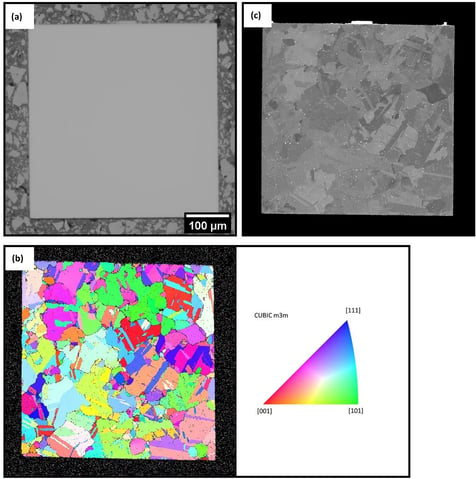
AFRL Additive Manufacturing Modeling Series: Challenge 2, Microscale Process-to-Structure Data Description
The Air Force Research Laboratory Additive Manufacturing Modeling Series was executed to create calibration and validation data sets relevant to models of laser powder bed fusion-processed metallic materials. This article describes the data generated for the 2nd of 4 challenge questions which was specifically focused on microscale process-to-structure modeling needs. This work describes the experimental methods, and the resulting characterization data collected from a series of single-track and multi-track deposits built with an EOS M280 from the nickel-based alloy IN625. In general, track dimensions followed common scaling behaviors as a function of processing parameters in quasi-steady-state regions, but significant systematic track geometry variations were quantified in transient regions with more dynamic energy input processes.
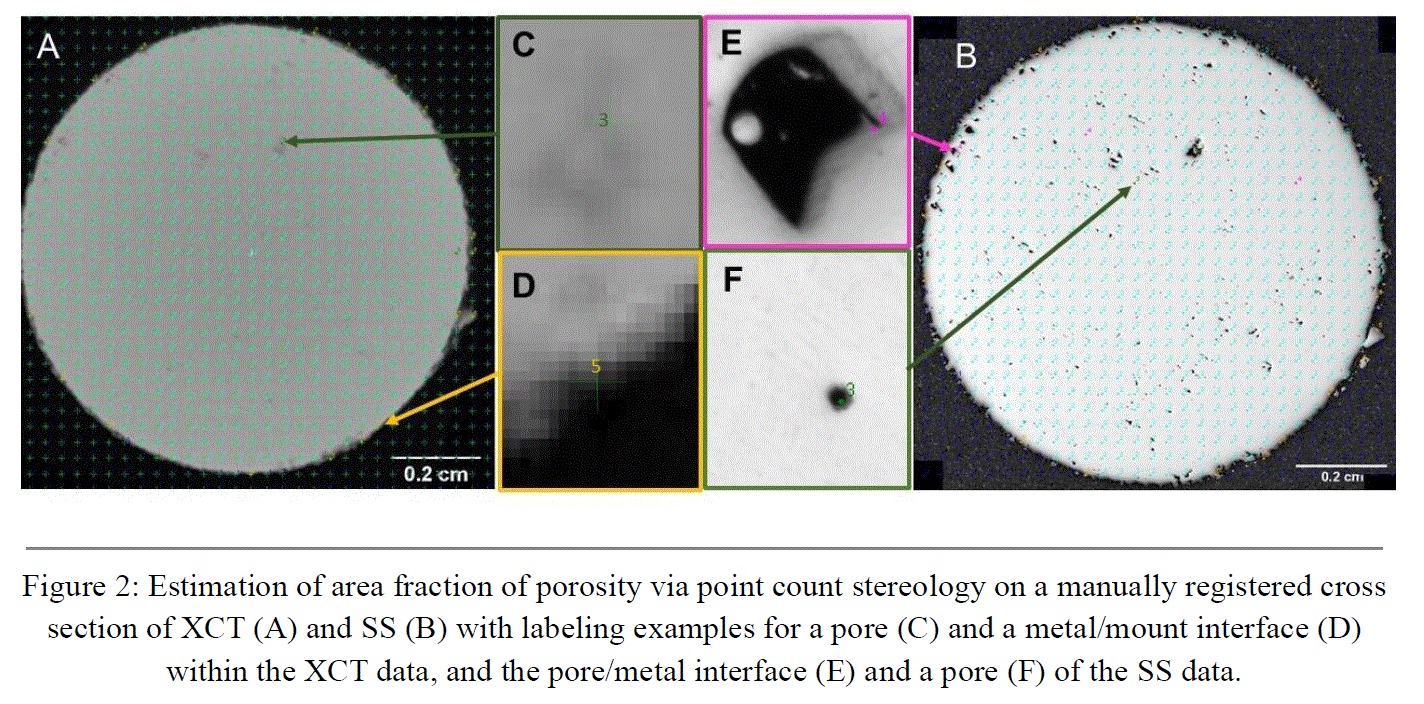 This study presents a correlative characterization of internal porosity within a Ti-6Al-4V (Ti64) additively manufactured sample. An x-ray computed tomography (XCT) reconstruction is compared to a mechanical polishing-based serial sectioning (SS) reconstruction over the same volumetric region. A 10-mm-diameter cylindrical additive manufactured sample was examined in this study, which was manufactured by laser powder bed fusion out of Ti64 virgin powder. Microfocus XCT imaging was conducted to characterize the internal porosity within the sample, at a voxel resolution of approximately 23 µm. After XCT imaging, a custom SS system was employed for optical microscopy characterization at a much finer spatial resolution—approximately 22 times—compared to the XCT reconstruction. The SS data were correlated with the XCT images of the sample. The methods used for segmentation of each data volume are discussed. The quantitative results of stereology, area fraction of porosity, and equivalent pore diameters are presented. The comparative results for manual data registration are also presented, as well as the future direction of research resulting from this current study.
This study presents a correlative characterization of internal porosity within a Ti-6Al-4V (Ti64) additively manufactured sample. An x-ray computed tomography (XCT) reconstruction is compared to a mechanical polishing-based serial sectioning (SS) reconstruction over the same volumetric region. A 10-mm-diameter cylindrical additive manufactured sample was examined in this study, which was manufactured by laser powder bed fusion out of Ti64 virgin powder. Microfocus XCT imaging was conducted to characterize the internal porosity within the sample, at a voxel resolution of approximately 23 µm. After XCT imaging, a custom SS system was employed for optical microscopy characterization at a much finer spatial resolution—approximately 22 times—compared to the XCT reconstruction. The SS data were correlated with the XCT images of the sample. The methods used for segmentation of each data volume are discussed. The quantitative results of stereology, area fraction of porosity, and equivalent pore diameters are presented. The comparative results for manual data registration are also presented, as well as the future direction of research resulting from this current study.The Alignment and Fusion of Multimodal 3D Serial Sectioning Datasets
This work comes to us from the specialized Robo-Met + SEM system at the NRL. As an example of data fusion in the context of 3D characterization of materials, this article demonstrates the procedures necessary to align and fuse separate imaging modes, traditional backscattered electron imaging (BSE) and electron backscattered diffraction mapping (EBSD), from serial-sectioning data. The fused data form a unified 3D reconstruction of additively manufactured 316L stainless steel processed by laser powder-bed fusion. We show that, by combining the relatively low-information yet high-fidelity BSE image stack with the more data-rich yet spatially distorted EBSD maps, the 3D reconstruction can leverage the strengths of both imaging techniques. The fully automated alignment procedures and frameworks rely on a number of optimized image warping techniques, with the result that spatial alignment errors are on the order of 0–3 μm within a region of interest that is >1 mm.
Citation: Nguyen, L. T., & Rowenhorst, D. J. (2021). The Alignment and Fusion of Multimodal 3D Serial Sectioning Datasets. JOM, 1-13.
Category: Composite Materials Applications
Identification and Quantification of 3D Fiber Clusters in Fiber-Reinforced Composite Materials
Citation: Schey, M. J., Beke, T., Appel, L., Zabler, S., Shah, S., Hu, J., ... & Stapleton, S. (2021). Identification and Quantification of 3D Fiber Clusters in Fiber-Reinforced Composite Materials. JOM, 1-14.
The Effects of Debulking on the Microstructure of Carbon Fiber Reinforced Composites
This work comes to us from researchers at U. Mass. Lowell and NASA GRC. Carbon fiber reinforced plastics (CFRPs) are widely used due to their high strength to weight ratios. A common process manufacturers use to increase the strength to weight ratio is debulking. Debulking is the process of transversely compacting a dry fibrous reinforcement prior to wet out with the matrix resin, in order to induce fiber nesting, effectively increasing the volume fraction of the sample. While this process is widely understood macroscopically its effects on fibrous microstructures have not yet been well characterized. The aim of this work is to compare the microstructures of three CFRPs, varying only the debulking step in the manufacturing process. The microstructural effects of debulking on three unidirectional CFRPs made from three different levels of debulking were studied. High resolution serial sections of all three samples were taken using the UES ROBO-MET at the NASA Glenn Research Center in Cleveland, Ohio. Using these scans, the fiber positions were measured and connected to make fiber paths. Statistical descriptors such as local fiber and void volume fractions, and void distribution and morphology were then generated for each sample and compared. Using these descriptors, the effects of debulking on the composite microstructure can be measured. This work was selected as a Solvay Best Student Paper Entry in The Proceedings of The American Society For Composites—Thirty-Sixth Technical Conference On Composite Materials, 2021.
Citation: SCHEY, M., STAPLETON, S., & BEKE, T. (2021). The Effects of Debulking on the Microstructure of Carbon Fiber Reinforced Composites. In Proceedings of the American Society for Composites—Thirty-Sixth Technical Conference on Composite Materials.
Read also:Robo-Met Publications in 2020 | 2019 | 2018 | 2017
Connect with us on Facebook, Twitter, LinkedIn, and Instagram.
Want to talk about how Robo-Met's potential for your specific application?
